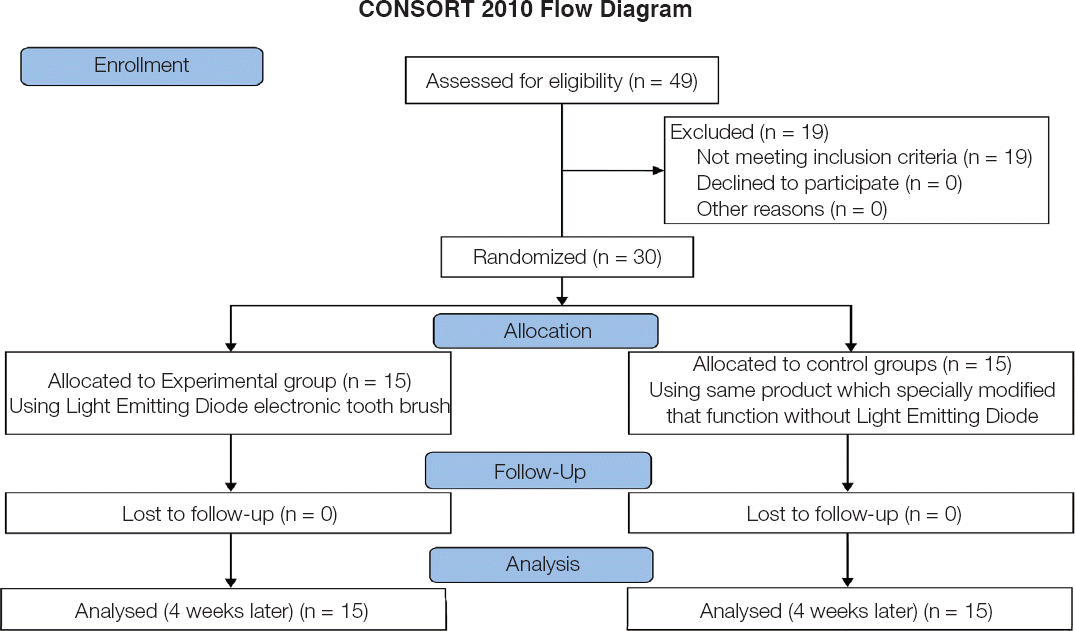1. Becker W, Becker BE, Berg LE. Periodontal treatment without maintenance. A retrospective study in 44 patients. J Periodontol. 1984; 55:505–9. DOI:
10.1902/jop.1984.55.9.505. PMID:
6592322.
2. Lindhe J, Westfelt E, Nyman S, Socransky SS, Haffajee AD. Long-term effect of surgical/nonsurgical treatment of periodontal disease. J Clin Periodontol. 1984; 11:448–58. DOI:
10.1111/j.1600-051X.1984.tb00902.x. PMID:
6378986.
3. Silverstone LM, Featherstone MJ. A scanning electron microscope study of the end rounding of bristles in eight toothbrush types. Quintessence Int. 1988; 19:87–107.
4. Hawkins D, Abrahamse H. Phototherapy-a treatment modality for wound healing and pain relief. African J Biomed Res. 2007; 10:99–109.
5. Wong-Riley MT, Bai X, Buchmann E, Whelan HT. Light-emitting diode treatment reverses the effect of TTX on cytochrome oxidase in neurons. Neuroreport. 2001; 12:3033–7. DOI:
10.1097/00001756-200110080-00011. PMID:
11568632.
6. Whelan HT, Connelly JF, Hodgson BD, Barbeau L, Post AC, Bullard G, Buchmann EV, Kane M, Whelan NT, Warwick A, Margolis D. NASA lightemitting diodes for the prevention of oral mucositis in pediatric bone marrow transplant patients. J Clin Laser Med Surg. 2002; 20:319–24. DOI:
10.1089/104454702320901107. PMID:
12513918.
7. Whelan HT, Houle JM, Donohoe DL, Bajic DM, Schmidt MH, Reichert KW, Weyenberg GT, Larson DL, Meyer GA, Caviness JA. Medical applications of space light-emitting diode technology - space station and beyond. AIP Conference Proceedings. 1999; 458:3–16. DOI:
10.1063/1.57600.
8. Whelan HT, Smits RL Jr, Buchman EV, Whelan NT, Turner SG, Margolis DA, Cevenini V, Stinson H, Ignatius R, Martin T, Cwiklinski J, Philippi AF, Graf WR, Hodgson B, Gould L, Kane M, Chen G, Caviness J. Effect of NASA light-emitting diode irradiation on wound healing. J Clin Laser Med Surg. 2001; 19:305–14. DOI:
10.1089/104454701753342758. PMID:
11776448.
9. Whelan HT, Buchmann EV, Whelan NT, Turner SG, Cevenini V, Stinson H, Ignatius R, Martin T, Cwiklinski J, Meyer GA, Hodgson B, Gould L, Kane M, Chen G, Caviness J. NASA light emitting diode medical applications from deep space to deep sea. AIP Conference Proceedings. 2001; 552:35–45. DOI:
10.1063/1.1357902.
10. Löe H, Theilade E, Jensen SB. Experimental gingivitis in man. J Periodontol. 1965; 36:177–87. DOI:
10.1902/jop.1965.36.3.177.
11. Lee SY, You CE, Park MY. Blue and red light combination LED phototherapy for acne vulgaris in patients with skin phototype IV. Lasers Surg Med. 2007; 39:180–8. DOI:
10.1002/lsm.20412. PMID:
17111415.
12. Lang-Bicudo L, Eduardo Fde P, Eduardo Cde P, Zezell DM. LED phototherapy to prevent mucositis:a case report. Photomed Laser Surg. 2008; 26:609–13. DOI:
10.1089/pho.2007.2228. PMID:
19025412.
13. Whelan HT, Buchmann EV, Dhokalia A, Kane MP, Whelan NT, Wong-Riley MT, Eells JT, Gould LJ, Hammamieh R, Das R, Jett M. Effect of NASA light-emitting diode irradiation on molecular changes for wound healing in diabetic mice. J Clin Laser Med Surg. 2003; 21:67–74. DOI:
10.1089/104454703765035484. PMID:
12737646.
14. de Sousa AP, Santos JN, Dos Reis JA Jr, Ramos TA, de Souza J, Cangussú MC, Pinheiro AL. Effect of LED phototherapy of three distinct wavelengths on fibroblasts on wound healing:a histological study in a rodent model. Photomed Laser Surg. 2010; 28:547–52. DOI:
10.1089/pho.2009.2605. PMID:
20001321.
17. Eells JT, DeSmet KD, Kirk DK, Wong-Riley M, Whelan HT, Ver Hoeve J, Nork TM, Stone J, Valter K. Photobiomodulation for the treatment of retinal injury and retinal degenerative diseases. Proceedings of Light-Activated Tissue Regeneration and Therapy Conference. 2008; 39–51. DOI:
10.1007/978-0-387-71809-5_5.
18. Erdle BJ, Brouxhon S, Kaplan M, Vanbuskirk J, Pentland AP. Effects of continuous-wave (670-nm) red light on wound healing. Dermatol Surg. 2008; 34:320–5. DOI:
10.1111/j.1524-4725.2007.34065.x. PMID:
18177400 .

